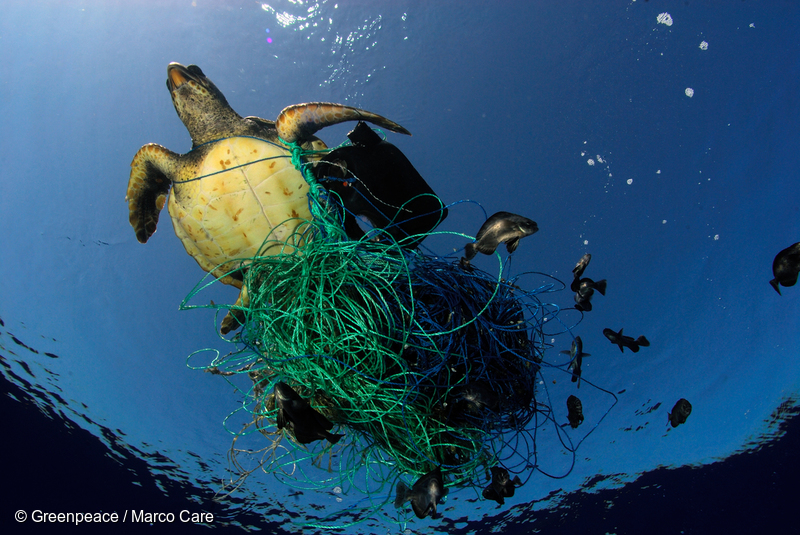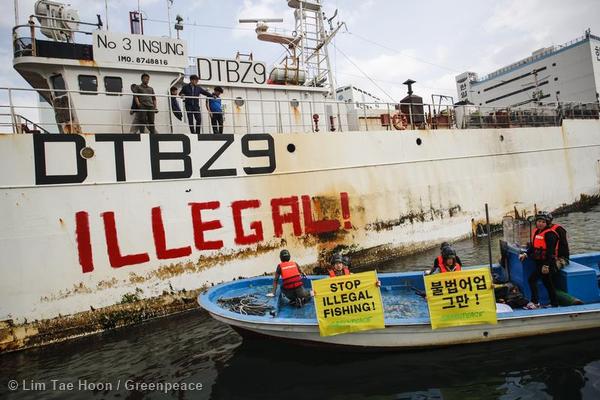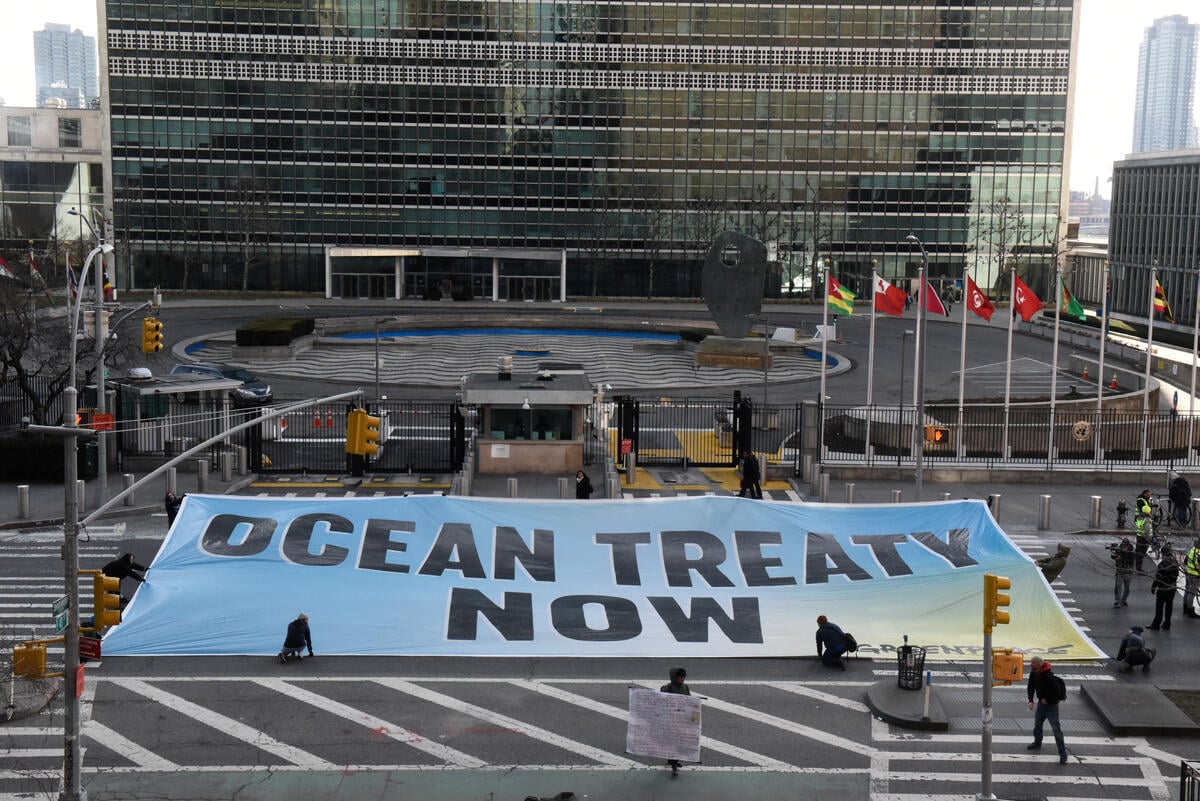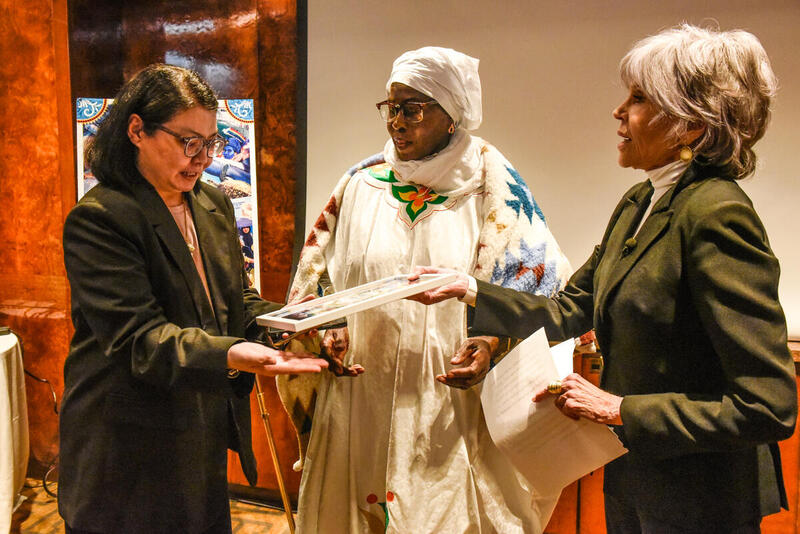Greenpeace Network calls for urgent protection under historic Ocean Treaty days before the Treaty opens for signature at the UN
Greenpeace International today released a major analysis of the cumulative impacts of ocean threats. The report, 30×30: From Global Ocean Treaty to Protection at Sea, finds that the threats from expanded industrial fishing on the High Seas, ocean warming, acidification, and pollution have severe and extensive impacts on the health of the oceans. It also delves into the emerging threat of deep sea mining, which would place even more strain on ocean ecosystems. It argues for urgent intervention and sets out a political roadmap to meet the United Nations’ goal of protecting 30% of the world’s oceans by 2030 under the new UN Ocean Treaty. The Treaty will be open for signing on September 20 at the United Nations General Assembly (UNGA).

The Rainbow Warrior is in the Mediterranean for a three month expedition “Defending Our Mediterranean”. Greenpeace is calling for the creation of marine reserves in the Mediterranean Sea, as part of a global network covering 40% of our seas and oceans.
Greenpeace Network calls for urgent protection under historic Ocean Treaty days before the Treaty opens for signature at the UN
Greenpeace International today released a major analysis of the cumulative impacts of ocean threats. The report, 30×30: From Global Ocean Treaty to Protection at Sea, finds that the threats from expanded industrial fishing on the High Seas, ocean warming, acidification, and pollution have severe and extensive impacts on the health of the oceans. It also delves into the emerging threat of deep sea mining, which would place even more strain on ocean ecosystems. It argues for urgent intervention and sets out a political roadmap to meet the United Nations’ goal of protecting 30% of the world’s oceans by 2030 under the new UN Ocean Treaty. The Treaty will be open for signing on September 20 at the United Nations General Assembly (UNGA).

The Rainbow Warrior is in the Mediterranean for a three month expedition “Defending Our Mediterranean”. Greenpeace is calling for the creation of marine reserves in the Mediterranean Sea, as part of a global network covering 40% of our seas and oceans.
Los Angeles, CA (September 13, 2023) – Greenpeace International today released a major analysis of the cumulative impacts of ocean threats. The report, 30×30: From Global Ocean Treaty to Protection at Sea, finds that the threats from expanded industrial fishing on the High Seas, ocean warming, acidification, and pollution have severe and extensive impacts on the health of the oceans. It also delves into the emerging threat of deep sea mining, which would place even more strain on ocean ecosystems. It argues for urgent intervention and sets out a political roadmap to meet the United Nations’ goal of protecting 30% of the world’s oceans by 2030 under the new UN Ocean Treaty. The Treaty will be open for signing on September 20 at the United Nations General Assembly (UNGA).
Arlo Hemphill, Greenpeace USA’s senior ocean campaigner, said: “The Ocean Treaty was a historic win for nature, but it remains nothing more than a symbolic document until it is signed, ratified, and implemented. This report demonstrates that threats to marine life are present almost everywhere in the world’s oceans, even in regions we once believed were so remote and difficult to access that human activity could never have an impact there. It is clear that immediate action is needed to stem the rising tide of destruction. The Biden Administration played a crucial role in securing the Treaty, and now it must lead the way in ushering in a new era of ocean governance by signing it as soon as it becomes open at the UN General Assembly in September.”
With a foreword from Professor Callum Roberts of the UK’s Exeter University, whose groundbreaking modeling provided the basis for the original 30×30 Blueprint for Ocean Protection [1], the report presents a new global analysis of high-seas fishing activity. Among the key findings was a staggering 22.5% increase in the hours boats spent fishing on the high seas between 2018 and 2022 in the areas scientists have recommended for protection under 30×30. Overall, there was an 8.5% increase (662,483 hours) in high-seas fishing hours between 2018 (7,825,411 hours) and 2022 (8,487,894 hours) [2]. These trends show reality at sea is moving in the opposite direction from the ambition laid out in the Treaty.
The report concludes that fully or highly protected ocean sanctuaries, which can be established under the Treaty, are a key solution to the ocean crisis. These sanctuaries provide a safe haven for marine life to recover and thrive free from human pressures. Currently, less than 1% of the high seas are adequately protected. To reach the 30×30 goal, over 4.2 million square miles of the ocean, roughly the size of the entire land area of the United States, must be protected every year.
Greenpeace International investigators have created a new publicly available interactive map that sets out the human pressures on the high seas and tracks the Treaty ratification status of all nations. The report also presents three case studies on uniquely special places on the high seas and the challenges they face for marine conservation: the Emperor Seamounts in the Northwest Pacific Ocean, the Sargasso Sea in the Atlantic Ocean, and the South Tasman Sea/Lord Howe Rise between Australia and New Zealand [3].
The report was launched aboard the Greenpeace ship Arctic Sunrise at an event in Long Beach, California, hosted by the Emmy award winning actress and activist Rosanna Arquette. It included a panel discussion with California Indigenous leaders about community-led ocean protection and a conversation with Samantha Murray (Scripps Institution of Oceanography) about ocean sanctuaries. Solomon “Uncle Sol” Pili Kahoʻohalahala, chair of the Hawaiian Islands Humpback Whale National Marine Sanctuary Advisory Council, delivered the Keynote address. The launch event kicks off a years-long campaign where Greenpeace ships around the world will conduct research that informs a science-based approach to the call on leaders to ratify the Treaty and to protect our oceans through marine sanctuaries.
Coastal communities, such as those in California, are on the frontlines of the ocean crisis. They feel the impacts of industrial extraction from the oceans first and are often the best custodians of their local waters. They are crucial allies in the fight against the ocean crisis. The Treaty gives us a chance to recognize and support their role in global ocean governance. As part of the consultation process around priority ocean sanctuary sites becoming protected areas, the global Greenpeace network will advocate for Indigenous leadership in naming and implementing these future ocean sanctuaries. In California, Greenpeace USA will work with the Chumash Indigenous Community, which is advocating for the establishment of the Chumash Heritage National Marine Sanctuary, which the Biden administration said “embodies the values of President Biden’s America the Beautiful initiative, and his commitment to supporting locally-led protections for cultural and natural sites across the country.” The National Oceanic and Atmospheric Administration (NOAA) is now asking for input from all stakeholders on the draft documents for the proposed Sanctuary.
Violet Sage Walker, Northern Chumash Tribal Council chairwoman and a nominator of the sanctuary, said: “Without the oceans, there is no life on this blue planet. In recent months, we have witnessed unprecedented challenges from historic high temperatures on land and at sea. These converging crises have had a profound impact on both people and our economies, underscoring the urgent need for swift and decisive action. It is essential that local communities like ours are included in global ocean governance. The Chumash Indigenous Community’s efforts to establish the Chumash Heritage National Marine Sanctuary in central California’s ocean waters represent a significant step towards enhancing ocean protection, which will ultimately benefit us all.”
Greenpeace International has partnered with Jane Fonda, Camila Cabello, and Simon Pegg to produce an animated short film that highlights the journey of three sea creatures as they escape the threats detailed in the report to find an ocean sanctuary.
Jane Fonda, a two-time Academy Award-winning actor and activist, said:
“The clock really is ticking down. 2030 is just over 6 years away now. That’s not much time when you consider the work we have yet to do. This Treaty can’t contribute to 30 by 30 without the signatures and ratifications that will allow us to go out, identify, and designate protected areas in some of the most important places in the global ocean – for biodiversity – and for the stability of our climate. Governments must sign this historic Treaty into law as quickly as possible, not in 10 years time, when it will be too late.”
###
Contacts:
Magali Rubino, Global media lead for Greenpeace’s Protect the Oceans campaign: [email protected] +33 7 78 41 78 78 (GMT+2)
Greenpeace International Press Desk:
[email protected], +31 (0) 20 718 2470 (available 24 hours)
Notes to editors:
- Photos and videos of the launch event on the Greenpeace ship Arctic Sunrise are forthcoming.
- The animated film is available for download and publication, and photo/video of the threats facing the oceans are also available. Further comment from Jane Fonda and Simon Pegg is available upon request.
- Data is available for journalists upon request
- The Treaty will open for signatures on September 20, 2023, during the annual meeting of world leaders at the United Nations General Assembly. Signing the Treaty does not require a legal process in domestic legislation but just indicates an intention to ratify it in the future. Ratification requires domestic legislation in each individual country. After 60 countries have ratified the Treaty, it will become legally binding.
[1] 30×30: A Blueprint For Ocean Protection, published in April 2019, was the result of a year-long collaboration between leading academics at the University of York, the University of Oxford, and Greenpeace International. The report presented a new approach to designing and creating a network of fully protected marine protected areas. The researchers broke down the oceans that are classed as ‘international waters—which cover almost half the planet—into 25,000 squares of 38.6 sq. miles and then mapped the distribution of 458 different conservation features, including wildlife, habitats and key oceanographic features, generating hundreds of scenarios for what a planet-wide network of ocean sanctuaries, free from harmful human activity, could look like.
[2] This analysis was conducted in collaboration with Global Fishing Watches, using their methodology for estimating fishing hours using AIS data.
[3] All the case studies’ areas are recognized as Ecologically and Biologically Significant Areas under the UN’s CBD



